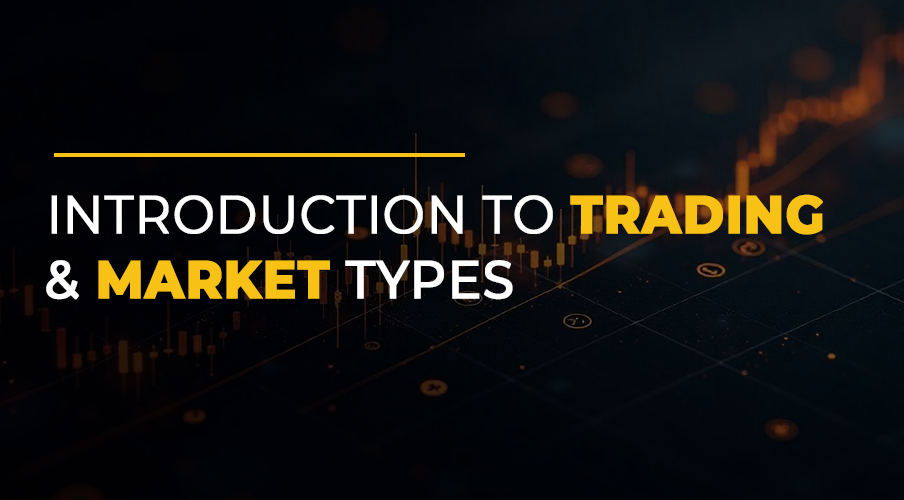FXCareers Blogs
 Go Back Home
Go Back Home

 24-06-2025
24-06-2025 5 minutes of Reading
5 minutes of Reading
Introduction to Trading & Market Types
Introduction to Trading & Market Types
1. What Is Trading?
Definition: Trading is the act of buying and selling financial instruments (stocks, currencies, commodities, cryptocurrencies, etc.) with the goal of profiting from price fluctuations over shorter horizons—minutes, hours, days, or weeks—rather than holding for years.
Trading vs. Investing:
- Trading aims to capture shorter-term price moves. For example, a trader might buy a stock expecting a pullback rally within days.
- Investing usually involves buying assets based on long-term fundamentals (e.g., company growth prospects) and holding for months to years.
Why Trade?
- Potential to profit in both rising and falling markets by using long or short positions.
- Flexibility to choose a style matching one’s schedule and temperament.
- Requires discipline, continuous learning, and risk management.
Example (recent): In June 2025, some traders capitalized on short-term rallies in U.S. equities after geopolitical news eased (e.g., U.S. stocks rallied ~1% on June 23, 2025). A trader might have bought into the S&P 500 expecting a rebound after a transient dip. This illustrates trading’s focus on near-term moves rather than holding through months of volatility.
2. Main Asset Classes & Markets
- Equities (Stocks):
- Shares of publicly listed companies on exchanges (e.g., NYSE, NASDAQ).
- Liquidity varies by company size; blue-chips tend to have tighter spreads.
- Example: On June 2025, after Fed signals about potential rate cuts, many tech stocks saw spikes in intraday trading volume as traders positioned for anticipated lower borrowing costs.
- Forex (Currencies):
- Trading currency pairs (e.g., EUR/USD) in the global over-the-counter (OTC) market, open 24 hours on weekdays.
- Liquidity peaks during overlapping sessions (e.g., London/New York).
- Example: EUR/USD showed bullish tailwinds in June 2025, with traders watching diverging central bank signals in the U.S. and Europe.
- Commodities:
- Physical goods like gold, oil, agricultural products, often traded via futures or CFDs.
- Sensitive to geopolitical events and supply/demand shifts.
- Example: Amid Middle East tensions in June 2025, gold saw inflows as a safe haven; some traders bought gold expecting volatility-driven rallies.
- Indices:
- Baskets of stocks representing broader market or sectors (e.g., S&P 500, NASDAQ 100).
- Allow traders to speculate on overall market direction rather than individual companies.
- Example: After a restrained geopolitical event in late June 2025, U.S. indices rallied, and traders used index ETFs or futures for quick exposure.
- Cryptocurrencies:
- Digital assets like Bitcoin, Ethereum. Highly volatile and traded 24/7.
- Recent context: Bitcoin traded around $100,000 in mid-to-late June 2025, with sharp intraday swings tied to macro news and sentiment shifts.
- Fixed Income/Bonds:
- Less common for active trading but relevant for hedging or yield strategies.
- Yields move with central bank policies; rising yields can affect equities and currencies.
- Derivatives (Options/Futures):
- Enable leverage, hedging, or speculating on price moves without owning the underlying asset outright.
- Require understanding of expiry, margin, greeks (for options).
- Beginner Tip: Approach derivatives only after grasping basics of the underlying markets.
Tip for Newbies: Start with one asset class you find interesting (e.g., equities or forex). Focus helps avoid overwhelm.
3. Trader Types & Timeframes
- Scalpers:
- Very short-term trades, holding seconds to minutes.
- Aim for small, consistent profits per trade; requires fast execution and low spreads.
- Often use direct-access platforms and monitor order flow or Level II data.
- Day Traders:
- Open and close positions within the same trading day.
- Avoid overnight risk (e.g., gaps due to news).
- Example: A day trader in June 2025 might buy oil futures in the morning anticipating a short-term rebound after an early dip caused by geopolitical headlines.
- Swing Traders:
- Hold positions for days to weeks to capture “swings” within a trend.
- Use technical patterns or momentum indicators on daily/4H charts.
- Example: In June 2025, a swing trader might go long a tech ETF after a correction, expecting continuation of a broader uptrend as earnings season approaches.
- Position (Trend) Traders:
- Longer horizons (weeks to months).
- Based more on macro fundamentals or long-term technical setups.
- Example: Taking a multi-week position in emerging market equities, given reports that emerging markets outperformed developed ones in early 2025.
Choosing Your Style:
- Assess personality: Do you enjoy fast-paced decisions (scalping/day trading), or prefer slower, less frequent trades (swing/position)?
- Time availability: Intraday trading requires being glued to screens; swing trades allow flexibility.
- Capital requirements: Some brokers impose minimums for certain styles or instruments.
Exercise: Reflect on your daily routine and temperament. Which style feels sustainable? Write it down as your initial focus.
4. Importance of Goals, Capital, and Risk Tolerance
Before trading real money, clarify:
- Capital Size:
- Only risk funds you can afford to lose.
- Example: If you have $5,000 for trading, risking 1–2% per trade means $50–$100 risk per trade.
- Risk Tolerance:
- Financial: How much drawdown (e.g., 10%) can you endure without depleting capital?
- Emotional: Can you remain calm after a series of losses?
- Example: During the April 2025 market crash, many traders faced sudden drawdowns; knowing your tolerance helps prevent panic-selling.
- Time Commitment:
- Intraday trading demands hours of chart-watching; swing trading may suit those with other jobs.
- Example: If you work full-time, swing trading on daily charts might fit better.
- Learning & Skills:
- Chart reading, technical indicators, fundamental analysis for longer-term trades, or coding for automated strategies.
- Example: Some traders in June 2025 automated parts of their routine alerts for economic releases, freeing time for analysis.
- Trading Plan Foundation:
- Define instruments, strategies or approaches, risk per trade, entry/exit rules, and routines.
- Example Entry Rule (simplified): “Buy EUR/USD when price breaks above a recent swing high on daily chart with RSI confirming momentum.”
- Example Exit Rule: “Set stop-loss below the breakout level; take profit at predefined risk:reward ratio (e.g., 1:2).”
Action: Draft brief answers:
- How much capital are you allocating?
- What is your acceptable max drawdown?
- Which timeframes suit your schedule?
- What skills or tools do you need to learn or set up first?
5. Market Hours & Structure
- Equities:
- Fixed exchange hours (e.g., US stocks: 9:30–16:00 ET), plus pre-/post-market sessions with lower liquidity.
- Example: A trader aware that during after-hours earnings releases, stocks can gap; many avoid holding positions overnight around earnings.
- Forex:
- 24-hour market Monday to Friday; liquidity peaks when London and New York sessions overlap.
- Example: In June 2025, a forex trader noted that EUR/USD volatility rose when both London and NY were open, offering better intraday swing opportunities.
- Commodities & Futures:
- Specific exchange hours (e.g., CME hours), but electronic trading extends beyond pit hours.
- Example: Crude oil futures might be more volatile during inventory reports; timing your trades around those windows requires knowing the schedule.
Checklist:
- Note trading hours for your chosen markets.
- Identify when major economic releases occur (e.g., central bank meetings, jobs data).
- Plan to avoid or specifically trade around high-impact events depending on your strategy and risk appetite.
6. Basic Risk Management Primer
Even at this introductory stage, instill good habits:
- Risk per Trade: Common guideline: risk 1–2% of equity per trade.
- Stop-Loss Orders: Always define your risk before entering.
- Position Sizing: Calculate size so that a stop-loss hit equals your predefined risk amount.
- Diversification: Avoid overconcentration in one instrument or correlated assets.
Example Calculation:
- Equity: $5,000; Risk per trade: 1% ($50).
- Suppose a forex trade has a stop-loss 50 pips away; then position size = $50 / (50 pips * pip value). If pip value per standard lot is $10, you trade 0.1 lot so that 50 pips = $50 risk.
Real-World Context: During sudden events (e.g., unexpected geopolitical developments in June 2025), wide spikes in volatility can trigger larger moves; having defined stop levels helps prevent catastrophic losses even if slippage occurs.
7. Setting Up Your Learning Routine & Tools
- Charting Platform:
- Choose one (e.g., TradingView, MetaTrader 5).
- Learn basics: drawing support/resistance, placing demo orders, reviewing past charts.
- News & Data Sources:
- Economic calendars (e.g., Forex Factory), reputable financial news (e.g., Bloomberg, Reuters).
- Example: In late June 2025, monitoring headlines about Middle East tensions helped traders anticipate spikes in oil and gold prices.
- Journaling Tool:
- Use a simple spreadsheet or dedicated journal to record each trade: date/time, instrument, entry, exit, rationale, outcome, emotions.
- Community & Mentoring:
- Engage in forums or study groups to exchange ideas; however, avoid blindly following signals without understanding rationale.
Summary:
Trading involves active participation to profit from price movements over shorter horizons. Key takeaways include understanding asset classes, selecting a trader style matching your personality and schedule, clarifying your capital and risk tolerance, knowing market hours, and establishing basic risk controls.

.png)

.png)
